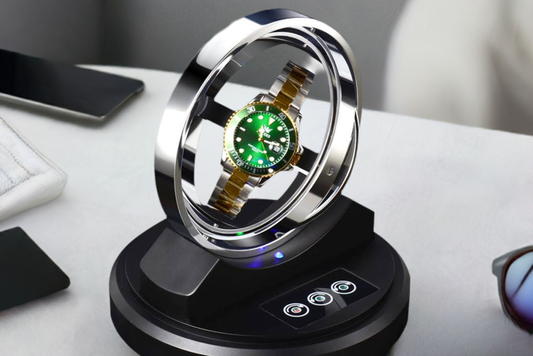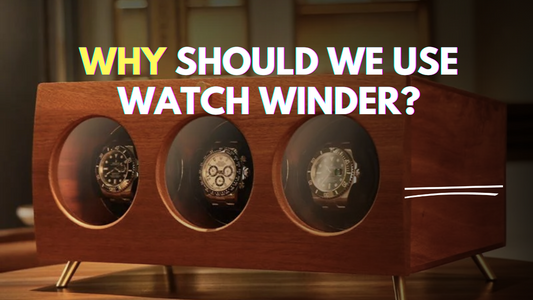Automatic watches are a marvel of horological engineering, combining the intricate mechanics of a traditional timepiece with the convenience of self-winding technology. Discover the secrets to maintaining your automatic watch with precision, from the basics of the self-winding mechanism to expert tips for first-time owners.
Understanding the Self-Winding Mechanism
At the heart of an automatic watch lies the self-winding mechanism, powered by the natural movements of your wrist. As you go about your day, a weighted rotor spins, harnessing kinetic energy to wind the mainspring. This ingenious system keeps your watch running without the need for daily manual winding.
Credit: YouTube Channel - Timed Square
Key Features and Benefits
Automatic watches offer a unique blend of craftsmanship, accuracy, and aesthetic appeal. With power reserves ranging from 36 to 72 hours, these timepieces can keep ticking even when not worn for a day or two. The intricate mechanical movements, often visible through a transparent caseback, showcase the watchmaker's artistry and attention to detail.
Winding Your Automatic Watch
While automatic watches are designed to wind themselves, there are times when manual winding is necessary, such as when the watch has been idle for an extended period. To wind your watch, follow these simple steps:
- Locate the crown on the right side of the watch case.
- Gently pull the crown out to the first position.
- Turn the crown clockwise for 20-30 rotations, or until you feel slight resistance.
- Push the crown back in to its original position.
For watches with screw-down crowns, like the Rolex Submariner ($7,000-$15,000) or the Omega Seamaster Planet Ocean ($5,000-$10,000), ensure the crown is fully unscrewed before winding and securely screwed back in place when finished.
When to Use a Watch Winder
If you own multiple automatic watches or don't wear your timepiece daily, a watch winder can be a valuable investment. These devices mimic the natural movements of your wrist, keeping your watch wound and ready to wear. Popular options include the Orbita Watch Winder ($200-$500) and the Wolf Watch Winder ($300-$1,000).
Caring for Your First Automatic Watch
As a new automatic watch owner, proper care and maintenance are essential to ensure your timepiece remains accurate and reliable for years to come. Here are some expert tips:
- Store your watch in a cool, dry place away from direct sunlight and magnetic fields.
- Have your watch serviced every 3-5 years by a qualified watchmaker.
- Avoid exposing your watch to extreme temperatures, typically above 140°F (60°C) or below -4°F (-20°C).
- Clean your watch regularly with a soft, dry cloth to remove dirt and moisture.
Building Your Collection
As you expand your automatic watch collection, consider investing in a watch winder or a watch box to keep your timepieces organized and properly maintained. Develop a winding schedule based on each watch's power reserve and your wearing habits to ensure your watches are always ready to wear.
Conclusion
Mastering the art of winding your automatic watch is a journey that combines technical knowledge, patience, and a deep appreciation for the craftsmanship behind these timeless pieces. By understanding your watch's unique features, following proper winding techniques, and providing regular care and maintenance, you'll ensure your automatic watch remains a cherished companion for years to come.
We hope this comprehensive guide has provided you with the knowledge and confidence to maintain your automatic watch collection. If you have any questions or experiences to share, please leave a comment below. And if you found this article helpful, don't forget to share it with your fellow watch enthusiasts!
Frequently Asked Questions
1. Can I overwind my automatic watch?
Most modern automatic watches are equipped with a mechanism that prevents overwinding. Once the mainspring is fully wound, the rotor will simply slip, preventing damage to the movement. However, it's still best to follow the manufacturer's recommended winding guidelines to ensure optimal performance.
2. How often should I wind my automatic watch?
The frequency of winding depends on your watch's power reserve and how often you wear it. If you wear your watch daily, it should maintain its power reserve without the need for manual winding. If you don't wear your watch for a day or two, give it a few turns of the crown to keep it running smoothly.
3. Can I wind my automatic watch while it's on my wrist?
While it's possible to wind your watch while wearing it, it's generally recommended to take the watch off your wrist before winding. This allows you to have a better grip on the crown and reduces the risk of putting unnecessary stress on the stem.
4. How do I know if my automatic watch needs servicing?
If you notice your watch running significantly fast or slow, losing its power reserve more quickly than usual, or experiencing other performance issues, it may be time for a professional servicing. As a general rule, it's a good idea to have your automatic watch serviced every 3-5 years to ensure optimal performance and longevity.
5. Can I replace the battery in my automatic watch?
Automatic watches do not use batteries. Instead, they are powered by a mainspring that is wound either by the natural movements of your wrist or through manual winding. If your automatic watch stops running, it likely needs to be wound or serviced, rather than having its battery replaced.

![How to Wind Automatic Watch: A Comprehensive Guide[2024]](http://uroro.com/cdn/shop/articles/use_ipad_sidecar_5.png?v=1716908885&width=1100)


